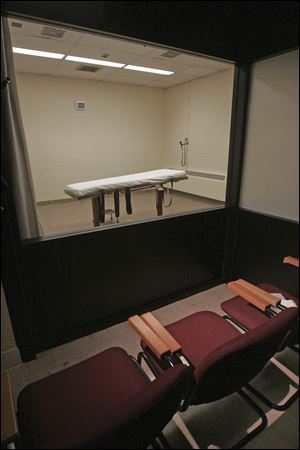
U.S. 6TH CIRCUIT COURT
Judges back temporary Ohio halt to executions
3-drug cocktail being challenged
4/7/2017COLUMBUS — A federal appeals court Thursday kept in place the temporary roadblock to Ohio’s plans to resume executions next month using a revised three-drug process.
A panel of the U.S. 6th Circuit Court of Appeals in Cincinnati voted 2-1 to maintain the preliminary injunction. It determined that enough questions remain as to whether the first drug — the anti-anxiety medication midazolam — would render a condemned inmate deeply unconscious and incapable of feeling pain as the second drug shuts down breathing and the third induces cardiac arrest.
BLADE BRIEFING: Ignazio Messina on Ohio executions
It found U.S. Magistrate Judge Michael Merz did not clearly err when he issued January’s injunction temporarily blocking executions while he considers whether the latest method is constitutional.
“Considering that the district court based its finding on its evaluation of testimony presented in a five-day evidentiary hearing, including competing expert testimony and eyewitness testimony about recent executions involving the same amount of midazolam called for in Ohio’s current three-drug protocol, the district court’s factual finding is not clearly erroneous,” Judge Karen Nelson Moore wrote for the majority.

The death chamber at the Southern Ohio Corrections Facility in Lucasville, Ohio.
“We are bound by the district court’s factual finding that ‘use of midazolam as the first drug in a three-drug execution protocol will create ‘a substantial risk of serious harm,’ ” the appointee of Democratic President Bill Clinton wrote.
Attorney General Mike DeWine’s office said it is reviewing the decision to determine its next step. It could ask the entire 6th Circuit bench or the U.S. Supreme Court to hear an appeal.
Opponents have argued that the new process could subject condemned inmates to unconstitutionally cruel and unusual punishment.
Ohio, like other states, has struggled to find the drugs it would prefer because their manufacturers object to their use in executions.
It has been more than three years since Ohio last carried out an execution — during which witnesses described Dennis McGuire, of Montgomery County, as struggling against his restraints and making snorting and choking noises for more than 20 minutes instead of falling unconscious according to plan.
The state then abandoned the two-drug protocol used in that execution. The first of those two drugs was midazolam.
The state now wants to use a revised three-drug process — a massive dose of midazolam, 500 milligrams, followed by rocuronium bromide, a paralytic agent, and finally potassium chloride to stop the heart.
Gov. John Kasich postponed eight executions after Judge Merz’s decision.
The execution of Ronald R. Phillips, convicted in the 1993 rape and murder of his Akron girlfriend’s 3-year-old daughter, is set for May 10.
Phillips was one of three plaintiffs in the case. The line of inmates with execution dates now extends into 2021.
Judge Raymond M. Kethledge, an appointee of Republican President George W. Bush, cast the dissenting vote.
“In sum, I will grant that the plaintiffs have shown some risk that Ohio’s execution protocol may cause some degree of pain, at least in some people,” he wrote. “But some risk of pain ‘is inherent in any method of execution — no matter how humane.’
“And the Constitution does not guarantee ‘a pain-free execution’. Different people may have different moral intuitions as to whether — taking into account all the relevant circumstances — the potential risk of pain here is acceptable. But the relevant legal standard, as it comes to us, requires the plaintiffs to show that Ohio’s protocol is ‘sure or very likely’ to cause serious pain.”
This case, he ruled, falls well short of that standard.
The second member of the majority, Judge Jane Branstetter Stranch, is an appointee of Democratic President Barack Obama.
The U.S. Supreme Court two years ago allowed Oklahoma’s use of midazolam as part of its process, finding that the plaintiffs failed to demonstrate the likelihood that condemned inmates would suffer severe pain.
The ruling upheld a decision by the 10th Circuit Court of Appeals.
The U.S. 11th Circuit last year also upheld a three-drug protocol used by Alabama that is similar to Ohio’s.
The 4th Circuit earlier this year refused to block a Virginia execution employing midazolam.
Robert Dunham, executive director Death Penalty Information Center — which collects and analyzes data on the death penalty but doesn’t take a position on it — said the conflicting circuit rulings are based on records developed in lower courts.
Ohio’s case stands out because of the extensive record developed by Judge Merz, he added.
“Ohio had five days of evidence,” he said. “This was the most extensive evidence presented in the country related to midazolam. The district court found that midazolam was likely to result in unconstitutional, tortuous death. The question for the 6th Circuit was whether the fact finding of the district court was supported by the record.”
Contact Jim Provance at: jprovance@theblade.com or 614-221-0496.